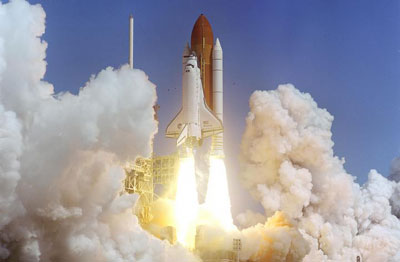The final shuttle flights: how expensive and how necessary?by Taylor Dinerman
|
| If the US cannot be counted on to even attempt to keep to its commitments on the ISS, then how can it expect to find partners for its long-term plans to build a base on the Moon and to explore the solar system? |
One alternative that has been discussed is to reduce shuttle preparation and maintenance work to one shift a day and thus to reduce the flight rate to something like two flights a year and ten or eleven total future missions. However, given the way the shuttle program has been structured and the safety requirements involved, it is highly doubtful that this cutback would actually save much money. Once the redundancy costs and the need to pay the remaining workforce ever higher bonuses in order to keep the best of them on the job have been calculated, the supposed savings might completely evaporate.
This cutback would certainly mean that the US would fail to keep any number of promises made to the international partners, beginning with the Japanese and the Europeans. A station with a full set of solar arrays, but without the European and Japanese facilities, would be a far cry from the “world class laboratory” that NASA promised to build only a few years ago. If the US cannot be counted on to even attempt to keep to its commitments on the ISS, then how can it expect to find partners for its long-term plans to build a base on the Moon and to explore the solar system? As one former astronaut put it, NASA could “look like a sick agency.”
An even more drastic idea is to cease all shuttle operations at once and to throw everything into the development of the Crew Exploration Vehicle (CEV), the Crew Launch Vehicle (CLV), and the Heavy Lift Launch Vehicle (HLLV). Under this plan the US would offer to fly the currently grounded components on the HLLV as soon as it is ready. According to NASA, however, at least some ISS elements will simply not fly on anything other than the shuttle. Experience shows that trying to fit a payload that had been designed for one launch vehicle into an alternative one is a very risky and expensive proposition. The expenses associated with storing the ISS components and of modifying the HLLV to take these payloads might consume a large part of the savings that such a program shutdown might be expected to generate.
Flying the full “eighteen plus one” program will certainly cost more than NASA had been originally planning to spend. It seems that there is no possibility of seeing any real reduction in shuttle operations costs until after the end of the program. The lesson from the way the Air Force’s Titan 4 program was successfully ended was that contractors and their employees must be asked to keep to a very high level of attention to detail. At the same time they know that their jobs will disappear once they have completed these very demanding tasks, therefore their pay and incentives must take this fact into account.
The shuttle program may be different because the lives of the crew would be jeopardized if anyone were to stop paying close attention to their work. No one can question the true commitment and dedication of the shuttle workforce. Yet we do have the examples of the failures that caused the Challenger and Columbia accidents that show that even with all the meticulous efforts involved in preparing the shuttle for flight, slip-ups do happen.
| To get through them this period will not only take hard work and careful attention to detail but also an unprecedented campaign of public information. Mike Griffin and his team will have to explain their plans to the public at every opportunity. |
In the current budget climate it will be difficult for NASA to ask for the extra funds needed to successfully finish all the shuttle missions, including the Hubble servicing mission, which looms large in the collective imagination of both the public and the US Congress. Yet the recently announced healthy growth of the economy and the gradual, if possibly temporary, drop in the price of oil could leave at least some slack in the overall budget that might allow for a modest increase in the civilian space budget for the critical years of 2008 and 2009. Even with an increase NASA will have to be very careful with its spending priorities; building the CEV and the CLV at the same time is not going to be easy, and NASA’s other programs will find it difficult to maintain themselves. Important scientific projects may have to be delayed and less important ones may be canceled.
These next few years are going to be exceptionally difficult for NASA and its contractors. To get through them this period will not only take hard work and careful attention to detail but also an unprecedented campaign of public information. Mike Griffin and his team will have to explain their plans to the public at every opportunity. They will have to make their case over and over, and to do so in a way that the public can easily grasp. The Vision for Space Exploration is a goal that a majority of Americans should instinctively support; to translate that instinct into a long-term, national, political commitment is something that only NASA’s leadership can do.
